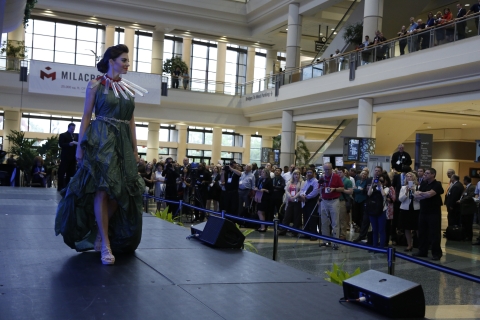National Plastics Exposition: Seven Decades of Audience Fascination

The plastics industry was still in its infancy when the first National Plastics Exposition (NPE) opened its doors in April 1946 at the Grand Central Palace in New York.
The Society of the Plastics Industry (SPI) was founded in 1937. Organizers realized industry professionals needed a place to meet face-to-face and discover the latest technology in real-life machinery, materials, and processed goods all in one place at one time. So once World War II ended, the opportunity to demonstrate equipment operating in front of an audience of thousands became a reality.
Plastics were a promising new development for consumers in postwar America and there was much curiosity, so that first show was open to the general public. Organizers had no idea just how popular this would be – around 87,000 people flooded the show before the fire marshal called things to a halt. (No edition of NPE has been open to the general public since.)
That first year, there were 164 exhibitors, mostly in 10-by-10-foot booths, totaling 24,600 square feet on two floors. All of the exhibitors were from the U.S. At the 2015 show, one exhibitor (Milacron) had a booth that was larger than the entire first showfloor.
During the early years, the show changed from an annual to biennial schedule and rotated between Chicago, New York, Philadelphia and Cleveland. In 1971, Chicago became the home for NPE, which officially switched to a triennial schedule in 1973. By that point, there were many machines – and even entire production lines – operating on the showfloor, as they still do today. At the 2015 show, more than 400 exhibitors featured operational machines.
“Both NPE and the plastics industry have changed dramatically since that first event,” said Mark Garrison, senior vice president of Membership and Business Development for SPI: The Plastics Industry Association. “The NPE program has kept pace with the growth and innovation in plastics as a whole – it’s still the best place for plastics professionals to get up-close and personal with plastics machinery while it’s working at full production capacity on the trade show floor.”
The show, which relocated to Orlando in 2012, has also become a fully international event. At NPE2015, nearly 44 percent of the 2,029 exhibitors came from other nations, along with 26 percent of the 65,810 registrants.
Over the decades, NPE has been a mirror of American culture and history. At the 1958 show in Chicago’s International Amphitheater, high-density polyethylene (HDPE) made its debut, most prominently featured in Wham-O’s 3-foot diameter Hula Hoops. Thanks to exhibitor giveaways, there were lots of Hula Hoops – and lots of Hula-Hooping – all around the showfloor.
On the final day of NPE at McCormick Place in 1963, shortly after 12:30 p.m. CST, news broke that U.S. President John F. Kennedy had been assassinated. Word spread rapidly across the showfloor and doing
business no longer seemed appropriate. The show closed far ahead of the scheduled 6:00 p.m. closing time.
NPE2015 was a milestone in the show’s 69-year history, and not just for breaking records in the number of exhibitors, attendees and space (1,128,200 net square feet). There was also the debut of the Zero Waste
Zone, a special area focusing on the industry’s mandate to reduce, reuse and recycle plastics. The Zone featured recycling demonstrations, products made with post-consumer recycled materials, and several special events.
A Pursuing Zero Waste Fashion Show was held at the show opening, featuring clothing designed by students from the Savannah College of Art & Design and made from recycled or reused plastics. The fashions were then on display in the Zero Waste Zone.
Surrounding the Zone was a Sustainability Pavilion featuring technologies that benefit the environment, and the Recycling Pavilion which hosted recycling technologies. But the recycling efforts didn’t end with the displays. NPE exhibitors teamed up to recycle 87 percent of the 518 tons of waste generated on the show floor.
Much of the success of NPE can be attributed to the industry involvement in planning and implementing the event. Members of exhibiting companies serve on the NPE Committee, which works in tandem with SPI’s trade show department and the show’s management firm to produce each show. NPE2015 was Np. 7 on TSNN’s Top 250 Trade Shows list.


Add new comment